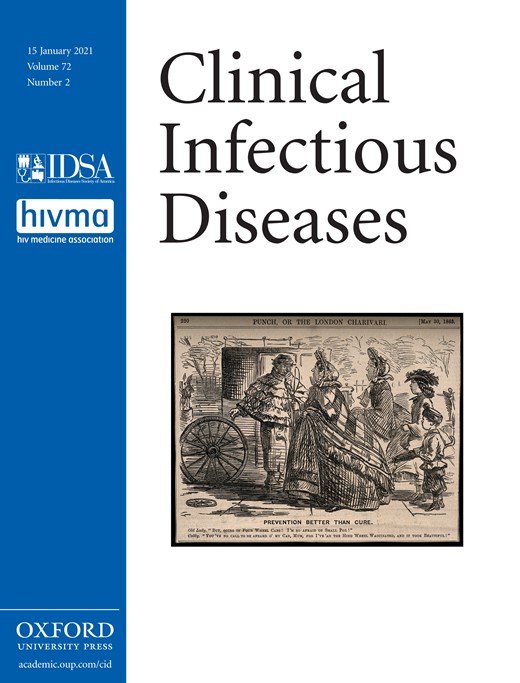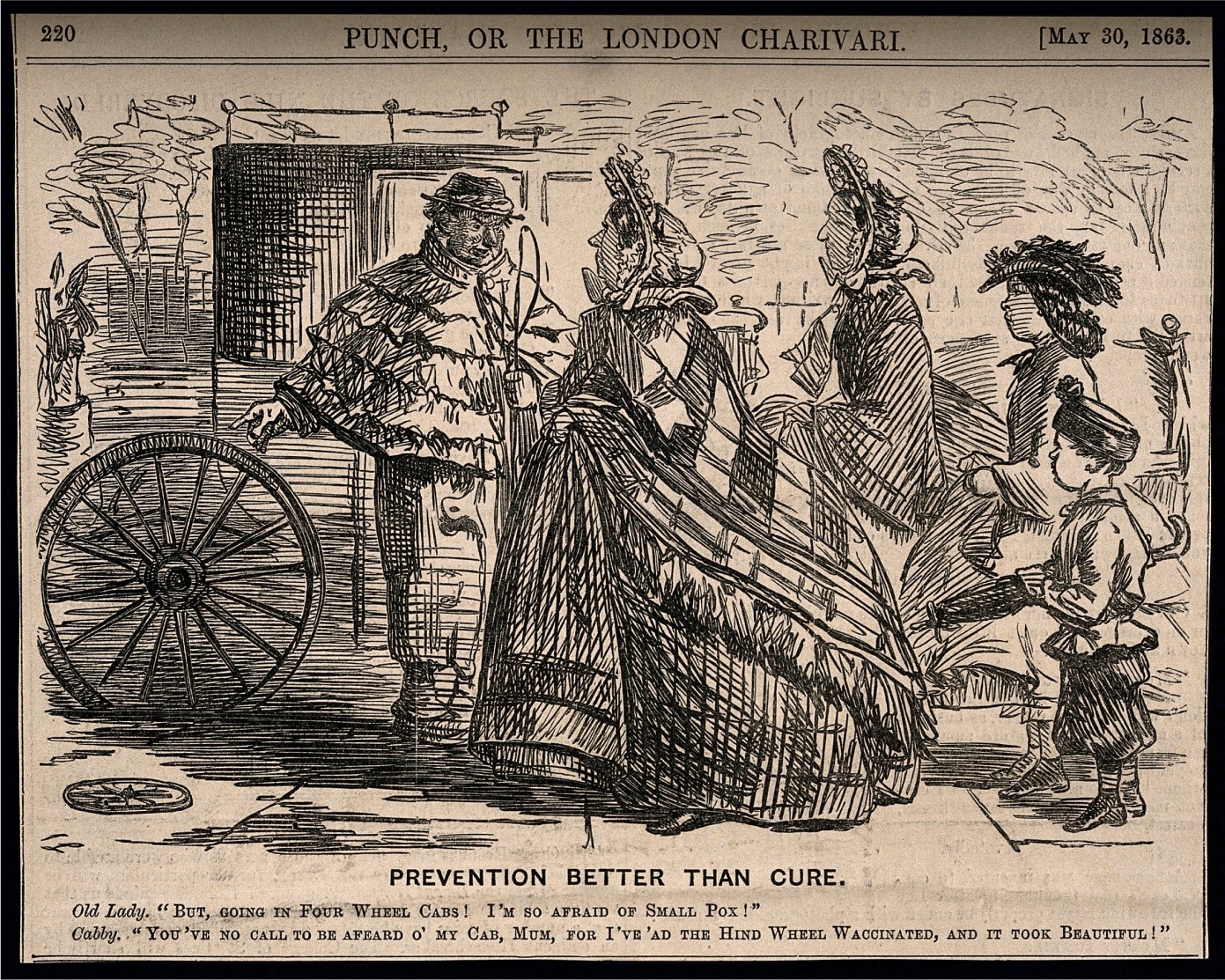
Cover image

Volume 72, Issue 2, 15 January 2021
IN THE LITERATURE
In The Literature
IDSA FEATURES
Clinical Practice Guidelines by the Infectious Diseases Society of America (IDSA): 2020 Guideline on Diagnosis and Management of Babesiosis
MAJOR ARTICLES AND COMMENTARIES
Epidemiology of Left Ventricular Assist Device Infections: Findings From a Large Nonregistry Cohort
We describe the incidence and epidemiology of left ventricular assist device (VAD) infections in a large nonregistry cohort of patients. VAD infections continue to be a frequent complication and are a heterogeneous group of entities with variable influence in outcomes.
The Need to Build Bridges Between Registry and Non-registry Studies in Ventricular Assist Device–Associated Infections
Hepatitis B Virus RNA as Early Predictor for Response to Pegylated Interferon Alpha in HBeAg-Negative Chronic Hepatitis B
Hepatitis B Virus-Pegylated Interferon (HBV-RNA) declined early during PEG-IFN treatment among patients achieved response and HBsAg loss. Serum HBV-RNA is a potential negative predictor of clinical response at week 12 of therapy. HBV-RNA may increase response rates to PEG-IFN treatment in HBeAg-negative patients.
Nasopharyngeal Microbiota Profiles in Rural Venezuelan Children Are Associated With Respiratory and Gastrointestinal Infections
The nasopharyngeal microbiota of rural Venezuelan children included several bacteria that thrive in tropical humid climates. Nasopharyngeal microbiota composition not only differed in children with a respiratory infection but also in those with a gastrointestinal infection.
Homotypic and Heterotypic Protection and Risk of Reinfection Following Natural Norovirus Infection in a Highly Endemic Setting
Infections with GII.4 noroviruses demonstrated both homotypic and heterotypic protection. However, increased hazard of subsequent infection following infection with several other common genotypes will require additional studies prior to the inclusion of additional genotypes in a multivalent vaccine.
Birth Cohort Studies: Toward Understanding Protective Immunity to Human Noroviruses
Decline in Hepatitis C Virus (HCV) Incidence in Men Who Have Sex With Men Living With Human Immunodeficiency Virus: Progress to HCV Microelimination in the United Kingdom?
We examined acute hepatitis C virus (HCV) incidence in men who have sex with men and living with human immunodeficiency virus between 2013 and 2018 in London and Brighton, United Kingdom. Incidence rates peaked in 2015 at 14.57/1000 person-years of follow-up (95% confidence interval, 10.95 to 18.20). Following this there was a 68% reduction in HCV incidence by 2018, coinciding with wider access to direct-acting antivirals.
Clinical Impact of Metagenomic Next-Generation Sequencing of Plasma Cell-Free DNA for the Diagnosis of Infectious Diseases: A Multicenter Retrospective Cohort Study
In a multicenter retrospective cohort study, we show that the real-world clinical impact of plasma metagenomic next-generation sequencing (mNGS) for the noninvasive diagnosis of infections is limited (positive impact, 7.3%). Further studies are needed to optimize the impact of mNGS.
Clinical Metagenomics for Bloodstream Infections: Is the Juice Worth the Squeeze?
Estimation of SARS-CoV-2 Infection Fatality Rate by Real-time Antibody Screening of Blood Donors
We initiated real-time nationwide anti–SARS-CoV-2 seroprevalence surveying of blood donations as a tool in monitoring the epidemic. The infection fatality rate was estimated to be slightly lower than previously reported from other countries not using seroprevalence data.
Serosurveillance for Severe Acute Respiratory Syndrome Coronavirus 2 (SARS-CoV-2) Incidence Using Global Blood Donor Populations
Comparing Dynamics and Determinants of Severe Acute Respiratory Syndrome Coronavirus 2 Transmissions Among Healthcare Workers of Adult and Pediatric Settings in Central Paris
Compliance to control measures allowed containment of the severe acute respiratory syndrome coronavirus 2 (SARS-CoV-2) outbreak in healthcare workers (HCWs). Medical masks in most situations and N95/FFP2 in aerosol-generating procedures largely protect HCWs against SARS-CoV-2. Small-sized childcare facilities may be acceptable to help HCWs stay at work.
First Reported Nosocomial Outbreak of Severe Acute Respiratory Syndrome Coronavirus 2 in a Pediatric Dialysis Unit
Forty-eight cases were involved in a nosocomial outbreak of SARS-CoV-2 infections in a pediatric dialysis unit due to person-to-person transmission. Our results outline strategies to trace and monitor SARS-CoV-2–infected healthcare workers including virology testing and infection control measures.
Impaired Cytokine Responses to Live Staphylococcus epidermidis in Preterm Infants Precede Gram-positive, Late-onset Sepsis
Preterm infants are uniquely susceptible to invasive bacterial infections, and predicting those at risk is currently not possible. The stimulation of peripheral blood with the common sepsis-causing pathogen, live Staphylococcus epidermidis, reveals impaired cytokine responses preceding the onset of sepsis.
Impact of a Publicly Funded Herpes Zoster Immunization Program on the Burden of Disease in Ontario, Canada: A Population-based Study
In this population-based study, introduction of a publicly funded herpes zoster vaccination program for all adults aged 65–70 reduced the burden of medically attended herpes zoster and herpes zoster–related emergency department visits and hospitalizations at a population level.
Incidence of Tetanus and Diphtheria in Relation to Adult Vaccination Schedules
We compared incidence rates of tetanus and diphtheria among 31 North American and European countries that do or do not implement adult booster vaccination programs. We found that routine adult booster vaccinations appear unnecessary after completion of the childhood vaccination series.
Risk Factors and Predictors of Mortality in Streptococcal Necrotizing Soft-tissue Infections: A Multicenter Prospective Study
This prospective study of streptococcal necrotizing soft-tissue infections comprised 126 Streptococcus pyogenes (GAS) cases and 27 Streptococcus dysgalactiae cases. Among the GAS cases, several factors were associated with mortality, including age, septic shock and no administration of intravenous immunoglobulin.
Magnitude and Kinetics of Anti–Severe Acute Respiratory Syndrome Coronavirus 2 Antibody Responses and Their Relationship to Disease Severity
In sera (n = 533) from patients with COVID-19 (n = 153), immunoglobulin M and immunoglobulin G responses, as measured by a quantitative immunoassay, were significantly higher in patients with severe than mild disease. These differences may affect strategies for seroprevalence studies, therapeutics, and vaccine development.
BRIEF REPORTS
The Facts About Vaccine Safety
Appropriateness of Antibiotic Prescribing for Acute Sinusitis in Primary Care: A Cross-sectional Study
To Induce Immune Reconstitution Inflammatory Syndrome or Suppress It: The Spectrum of Mycobacterium genavense in the Antiretroviral Era
Coronavirus Disease 2019 Pandemic: Impact Caused by School Closure and National Lockdown on Pediatric Visits and Admissions for Viral and Nonviral Infections—a Time Series Analysis
Occurrence and Timing of Subsequent Severe Acute Respiratory Syndrome Coronavirus 2 Reverse-transcription Polymerase Chain Reaction Positivity Among Initially Negative Patients
VIEWPOINTS
From Easing Lockdowns to Scaling Up Community-based Coronavirus Disease 2019 Screening, Testing, and Contact Tracing in Africa—Shared Approaches, Innovations, and Challenges to Minimize Morbidity and Mortality
The coronavirus disease 2019 (COVID-19) crisis presents a unique opportunity to align COVID-19 services with those already in place for human immunodeficiency virus, tuberculosis, malaria, and other noncommunicable diseases through mobilization of Africa’s interprofessional healthcare workforce to contain the pandemic.
One Hundred Days of Coronavirus Disease 2019 Prevention and Control in China
The first 100 days of China’s response to COVID-19 with specific, simple, and pragmatic strategies used for risk assessment, prioritization, and deployment of resources are critical for its rapid control of the epidemic and restarting of social life and economic activity.
REVIEW ARTICLE
COVID-19 in Immunocompromised Hosts: What We Know So Far
Based on existing data on COVID-19 among immunosuppressed patients, it appears that organ transplant and cancer patients may be at increased risk of severe disease and mortality, whereas the risk among patients with other types of immunocompromise is less clear.
INVITED ARTICLE
IMMUNOCOMPROMISED HOSTS
Are All Patients with Cancer at Heightened Risk for Severe Coronavirus Disease 2019 (COVID-19)?
Despite initial reports, SARS-CoV-2 infection in cancer patients is not universally associated with poor outcomes. This viewpoint critically discusses the potential impact of the underlying malignancy and cancer therapies in COVID-19 outcomes, emphasizing the need for improved mechanistic understanding of the many faces of SARS-CoV-2 infection in this heterogeneous group of patients.



